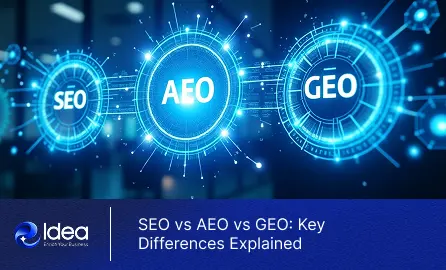In 2025, the way people search has transformed dramatically. Gone are the days when typing keywords into Google was the only path to discovery. Voice assistants, AI chatbots, generative engines, featured snippets, and “zero-click” answers are increasingly replacing traditional search behaviours. If your digital marketing strategy still relies purely on classic SEO, you may be missing out on newer visibility channels: Answer Engine Optimization (AEO) and Generative Engine Optimization (GEO).
At e-idea CS, we have seen how each plays a unique role in shaping digital visibility. Businesses often focus on one while overlooking the others, but the reality is that success today requires balance across all three.
In this post, we will break down SEO vs AEO vs GEO—what they are, how they differ, why all three matter, and how you can optimize your website and content to succeed across all fronts.
Traditional SEO has long been the backbone of online visibility. It is the set of practices designed to make your web pages rank higher in search engine result pages (SERPs) like Google, Bing, etc. It includes keyword research, content creation, backlink building, technical optimisation (site speed, mobile-friendliness), and ensuring great user experience.
AEO is about making sure your content is crafted so that answer engines—or features like featured snippets, voice assistants, “People Also Ask” boxes—can pull direct, concise answers from your content without requiring the user to click through. It is more about answering the question clearly and structuring content for the engine to extract the answer.
GEO refers to optimizing content for generative AI engines—i.e., those that don’t just respond with a list of links, but synthesize answers from multiple sources (for example ChatGPT, Google’s Search Generative Experience, Gemini, etc.). GEO’s goal is to be cited, referenced, and used as a source in AI-generated summaries or responses.
Here are practical, actionable steps you can take to cover all three.
Marketer A had a blog about “Digital Marketing Metrics”. Initially, their strategy was pure SEO: long-form 2000-word content, keyword targeting, and some backlinks. They ranked in the top 5 for several keywords, but traffic growth plateaued.
Then they optimized some posts for AEO: added FAQ schema, inserted concise answers, and restructured content to support featured snippets. They saw snippet appearances within 4–6 weeks.
Next, they tackled GEO: added expert author bios, included original stats/case comparisons, and made content more semantically rich. They also monitored AI tools and saw their posts being cited in AI summaries.
Outcome: The Combined strategy boosted organic traffic by ~30%, enhanced visibility in “People Also Ask”, voice search, and they began getting referred via AI summarizations (e.g. small lifts in branded search queries & engagements).
Search behaviours will keep evolving, but one thing remains constant: the need for clarity, authority, and adaptability. To expand your reach, attract the right audience, and shine brighter across every platform, get in touch with e-idea CS today—and let’s build a digital strategy that delivers real results.


